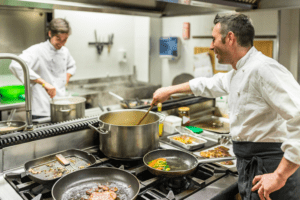
Thinking of advertising your restaurant as gluten-free? If you don’t have dietary restrictions yourself, you may have questions about what it means to be gluten-free, what gluten-free customers want, and how you can safely serve them with confidence. You’ve come to the right place for answers—Beyond Celiac is approaching our 20th anniversary, and we’ve seen a lot in the past two decades. This article compiles some of our top recommendations for restaurants who want to serve truly gluten-free food.
But before we jump into making a restaurant gluten-free, let’s take a look at what the gluten-free diet is all about.
Gluten is a protein found in wheat, barley and rye. Given the widespread use of wheat flour as a filler and thickener, it frequently appears in sauces, spices, and soups, in addition to the usual culprits like whole wheat bread, pasta, and pastries.
For some, eating gluten-free is a medical necessity, with no such thing as “cheat days.” Most of these people have one of three gluten-related disorders: celiac disease, non-celiac gluten sensitivity, or a wheat allergy. (You can click on each disorder to learn more about it.) For someone with one of these disorders, accidentally ingesting a tiny amount of gluten could have serious, long-term medical consequences.
In recent years the gluten-free diet rose to prominence for being a weight-loss diet. There are many reasons some people may have lost weight while eating gluten-free, but in general there is little evidence to suggest eating gluten-free is a healthier choice for those that do not have a gluten-related disorder.
Eating out is one of the most stressful experiences for someone with celiac disease. Having to explain and defend their diet and then worry about potentially becoming ill after their meal can make it hard to enjoy eating. With a gluten-free restaurant, they can fully enjoy delicious food, safe cooking, and time with family and friends.
Most of us with celiac disease have only a few options to choose from when eating out, so we tend to return to the same places again and again. Once we know a restaurant is safe, we are likely to be a steady, repeat customer. The gluten-free community will appreciate your switch to being gluten-free, and gluten-eating customers can still enjoy your menu, too. It’s a win-win!
Although it may seem daunting at first, the switch to being gluten-free is feasible for many restaurants. Your local celiac disease community and anyone else eating gluten-free will deeply appreciate your work and your food.
Want to keep up to date with celiac disease? Follow us on our official social media handles: Twitter, Facebook, and Instagram. We regularly post great information there, which you can re-share on your accounts, too.
Opt-in to stay up-to-date on the latest news.
Yes, I want to advance research No, I'd prefer not to